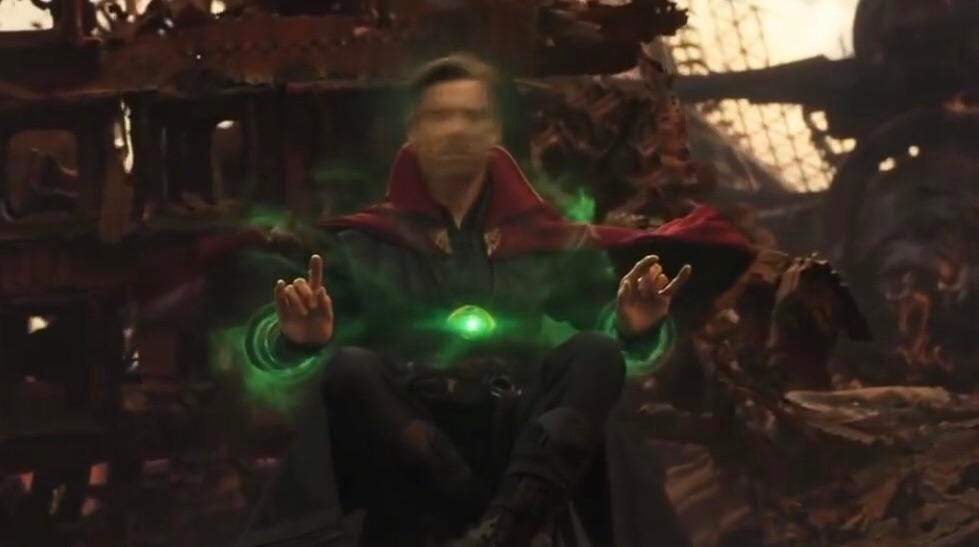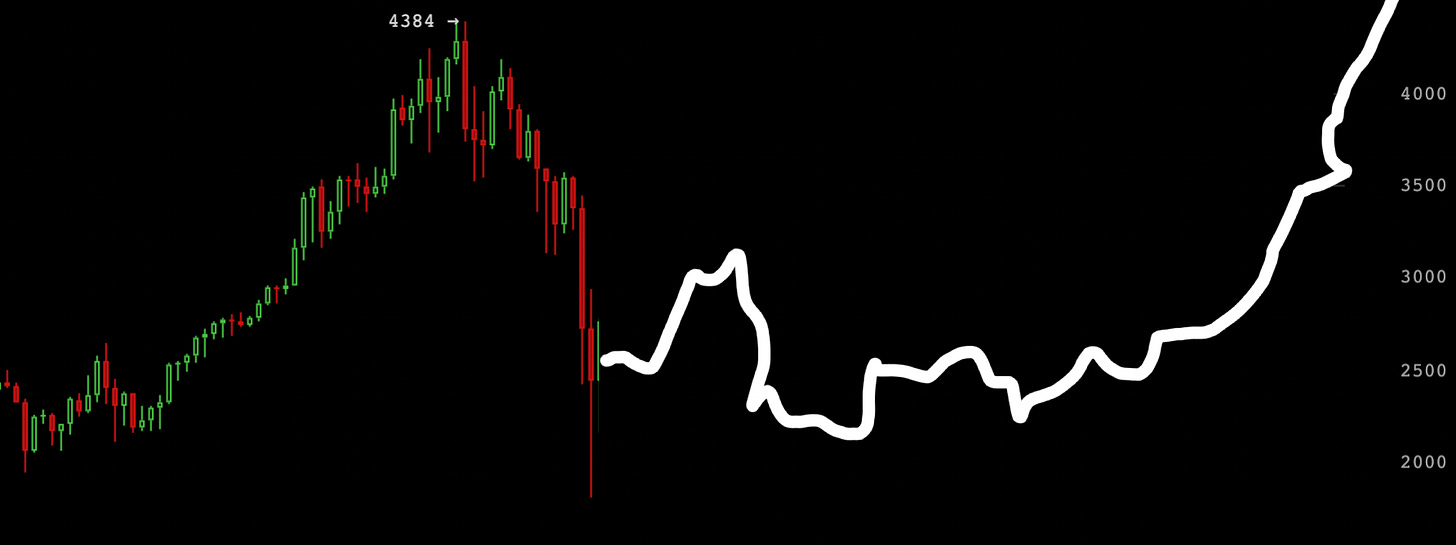Probabilistic thinking
New entrants in the crypto community look to crypto “veterans” hoping for near-deterministic directional insight into these perplexing markets.
So, in this post, I will show you how to see the future.
Seeing the future
Successful crypto veterans know that crypto trading is a probabilistic outcomes business. Probabilistic thinking is basically just trying to estimate the likelihood of a specific future outcome becoming reality.
To my knowledge, seeing the future is currently impossible. Traders must instead predict the future by first seeing every possible future.
Oh, and none of this is investment advice. I’m not a professional and mostly am stumbling my way through the world the same way I was at age 13. Just documenting and sharing some thoughts and none of it is a science. I, like everyone else, am simply an aged baby walking blindfolded into a forest, startled by my own humanity.
Anyway, to illustrate with reality rather than a Marvel movie reference, let’s go back in time. Here’s what the 1D ETHUSD chart looked like at daily close on May 19th.
When the market crashed in May, it took 8 days for Ethereum to go from around $4400 to below $1800.
During the crash, you could consider four possible scenarios for the future. I tweeted about them as we broke down below $2000.
In case it helps, I have drawn some embarrassingly lo-fi versions of what the future charts might have looked like in each scenario.
1. The market has experienced another 2017-style boom/bust cycle and the top is in. We can expect a classic crypto “complacency shoulder” pattern.
2. The market will cool off before experiencing a 2013-style double-bubble and be bullish again towards the end of the year.
3. The market will go down-only and experience an almost unprecedented level of rekt.
4. The market will instantly recover and rocket to new highs very quickly.
There are of course slight variations of each idea above, as well as other potential scenarios that I didn’t bother considering because I thought they were too unlikely (eg. sideways forever).
After accounting for all the possible things that could happen, good traders will evaluate how likely they believe each scenario to be. At the bottom of the crash, they could be weighted something like this:
p(1) = 45%
p(2) = 45%
p(3) = 5%
p(4) = 5%
In effect, you believe scenario 1 and 2 are equally likely outcomes at 45% each and they are also the two most likely possible outcomes, but you are also considering that 3 and 4 may be possible too.
If you evaluate the best possible trade for each scenario above, they are pretty simple:
1 — buy: buy the lows and sell the classic complacency shoulder pattern
2 — buy: buy the lows and hold for new highs
3 — sell: it’s going to actual zero
4 — buy: new highs by end of day, lfg
By these estimations, buying is the best trade in 95% of scenarios. There is an estimated 50% chance for new highs, a 45% chance for selling slightly below the previous all-time-high, and a 5% chance of getting completely rugged.
Specifically:
45% chance of +80% pnl (buying $2000 and selling complacency shoulder around $3600)
50% chance of more than +100% pnl (buying $2000 and selling above new highs)
5% chance of -20% pnl (buying $2000, market to new lows, cutting losses at $1600)
Now the trade seems simple: buy at $2000, re-evaluate near $3600, and stick to the exit plan in case of the scenario where the market is getting rugged into new lows. 95% scenarios make at least +80%. 5% scenario loses -20%. That seems worth the risk.
If a trader was already holding and hadn’t yet exit, either before the crash or early during the crash, they could still use this information and estimates to decide to hold, rather than panic-selling into Alameda’s bids at the lows.
Doge & Elon
I spoke about this a little in the previous post wrt attention, but I think it’s relevant here as well.
Elon tweeted about Doge a bunch through 2019 and 2020. During this bullrun, he started shilling Doge again below $0.01. I actually don’t remember exactly and I certainly don’t care enough about this blog post to do research. Let’s just agree that it was at $0.01. The chart looked like this:
The future scenarios may look like this:
He keeps shilling it and it goes up.
He keeps shilling it and it fails to go up.
He doesn’t shill it anymore but it pumps anyway.
He doesn’t shill it anymore and it goes down.
Where:
p(1) = 75%
p(2) = 10%
p(3) = 7.5%
p(4) = 7.5%
Since Elon shilled it throughout 2019 and 2020, you can say it’s actually probably quite likely that he will lean into the euphoria of the markets looking better and effectively pump doge a bit.
Of course, he might shill it but be ineffective at pumping it. And he might get reigned in by a compliance team or some advisor and not tweet about it like he did in 2019 and 2020.
In the scenarios where it goes up (p(1+3)=82.5%), a finger-in-the-air but conservative estimate has an upside of 350% (which would be doge hitting 3 or 4 cents). In the scenarios where it doesn’t (p(2+4)=17.5%), it would be possible to sell somewhere between current price and failing to keep the previous sideways price floor — maybe down 50% in the worst case scenario.
By these estimates, there’s a 82.5% chance of making a 3-4x multiple on this bet, and a moderate to small chance of losing 50% of the bet. Again, seems worth the risk.
How do you estimate probability of a scenario? Or price upside?
I am intentionally oversimplifying this a lot and I promise not to write about cumulative distribution function of returns or anything, but do think it’s worth exploring some of the nuance in estimating possible futures and probabilities.
I assume the primary questions are: How do you come up with the potential scenarios, and how do you estimate their likelihood? Honestly, you just kinda guess. And you hopefully get better at it over time.
A good way to inform your guesses about the future is to look at what has happened in the past. This anthropological reflection on markets and assets can give hints about what might happen in the future, since the past was created by a crowd of people who were likely similarly intelligent, and dumb, and emotional, and irrational and etc as the current crowd of people existing in the present.
You can ask simple questions of history, such as:
Has there been a drawdown of over 50% that didn’t signal the end of the bull market? If so, what was the previous max mid-cycle drawdown?
What happened after -30% drawdowns in the past? Is there any reason why it would be different this time?
How did Doge perform against Bitcoin historically in bull markets? What are some conservative upper targets for DOGE/BTC pair?
How did extremely high-attention and hyped altcoins grow in the past? What did their charts look like? Are there charts that look like currently hyped ones look?
What multiple did Bitcoin increase from the previous all-time-high (2013) to the next one (2017)? Is that multiple reasonable for assets that have a similar market cap to what Bitcoin did in 2017?
What usually happens when an asset gets added to big exchanges, like Coinbase, Binance, etc?
History doesn’t repeat itself, of course. But Twain might tell you that pattern matching to historic data from directly or tangentially related markets can help inform a model of estimates about the future: where prices might go, and how likely a scenario is.
Experienced traders know a lot more about markets, so instead of answering simple questions like above, they’re more likely to ask to significantly more complex questions about the past and including multiple market metrics into those questions. They’ll consider stuff like open interest, order flow, volume profiles, entropy or who knows what they find reliable or informative. But it’s the same general idea and approach even as the historic comparisons get increasingly complex.
Don’t try this at home
Retail traders are often bad at evaluating the attributes of a crypto asset, as they are unfamiliar with the technological or fundamental merits — but they’re also quite bad at evaluating the price behaviour of a crypto asset, since they are unfamiliar with trading concepts, price charts and financial markets. And if a trader is making shitty or biased estimates as to what could happen in the future, then they’re calculating bad probabilities and probably losing all their money.
Realistically, I think 95% of people reading this should probably not be actively trading crypto markets. Simply having exposure to the fastest growing asset class of the last decade is good enough, and the potential upside of winning some trades is not worth the risk of you losing that exposure. If crypto does fulfill its societal mission, there is still a gigantic amount of long-term upside and it’s better to just survive than try to maximise short-term gains.
But I know many of you are absolute reprobates so I will be realistic with my request. Instead, I will only take this moment of your attention to encourage that you take off a little risk. Take things a bit slower. Push out your “get rich quick” time horizons. Start to journal some probabilistic thinking into your trades or investments and reflect afterwards on why you lost your money without blaming market manipulators or Three Arrows Capital. Although it probably was Su’s fault, so I sympathise.
Anyway, not investment advice, this just some of the ways I and others I have spoken to think about short/mid term price action in an attempt to stay rational. But Sam says go all-in and he’s a deca-billionaire so I’m reconsidering things.










Cobie the philosopher
all hail cobie the savior of my portfolio